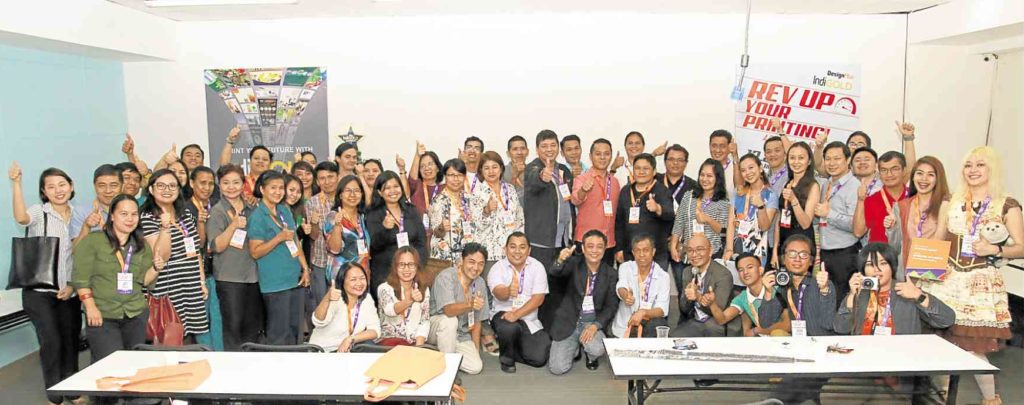Printing shop spawns brokering businesses
Is it possible for someone with no printing equipment, no money, and only the most rudimentary printing technical knowledge to go into the printing business and succeed in it?
Maldwyn de Pano, president of Design Plus Inc., thinks so, even as he shows off a database of 800 print brokers affiliated with him.
He explains what a print broker is.
Printing shops (suppliers) need agents to locate customers for them. In the classic supplier-customer business model, this function is performed by sales representatives and account executives it employs on salaried or commission basis.
In the new business model Design Plus recently adopted, a layer is added between supplier and customer.
Print brokers are independent, formally registered businesses. As go-between, they serve both customer and supplier. Customers rely on print brokers’ knowledge of the printing process to understand and make valid decisions on their printing orders. On the other hand, print brokers help printing suppliers, like Design Plus, increase their market base and profit potential. When a problem arises in the course of production, it is the broker’s job to find out what happened and mediate solutions satisfactory to both customer and supplier.
Since 2014, Design Plus has been implementing a print broker development scheme known as the Indigold Advantage Program.
The program trains aspiring brokers on the basics of printing, cost estimating, quotation preparation, and other tools to enable them to serve as effective printing middlemen.
He was himself a print broker at one time in his 40-year printing career.
As a fresh graduate of the University of the Philippines College of Fine Arts, De Pano joined the National Housing Authority (NHA) where he headed the graphic section of the communications department, taking charge of designing, laying out and producing the agency’s marketing collateral.
In this capacity, he used to spend the better part of his working hours in the printing press, making sure his creative ideas were faithfully translated into print.
By nature inquisitive and observant, he mastered the whole spectrum of the printing process as well as its financial aspects.
One of his first realizations was the capital intensiveness of putting up a well-equipped printing shop. Another realization: Compensation he received from his designs could increase manifold if he were to do the printing himself.
By 1982, he resolved to quit NHA to put up his own shop.
Taking a loan from his father, he looked around for an offset machine to get going. He settled for a second-hand, decrepit machine almost as old as he was. An outdated model, it needed replacement parts no longer available in the surplus market and took months to fabricate.
Once fixed, the machine was installed in a cramped apartment unit in Malabon that served as Design Plus’ first office. He then acquired binders, stitchers, cutters and other peripheral equipment. With a work force consisting of himself, his wife, and his mother-in-law, he was ready to go.
Early on, he made it a point to live up to the “Design Plus” name. The “plus” signified for him, the extra attention and effort he devotes to every job he accepts. This premium in effort became the competitive edge that accounted for repeat orders and word-of-mouth referrals.
His market base grew slowly but steadily, requiring expanded capacity. Soon, he was operating in a two-story workplace (converted from an old house in Project 7, Quezon City) equipped with four offset machines.
In 2012, he took a leap of faith and got, on a bank loan, a brand-new, multicolor machine, for a sum he could only describe as “unprecedented” in his capital investment history. One day in 2014, De Pano took stock of his financial situation. He was up to his neck in debt on investments that gave him quality and speed. Clearly, he needed to multiply production volume in order to maximize his expanded capacity.
Hiring more marketing staff would have meant new investments in human resource management. He created instead a network of independent marketing-oriented entrepreneurs whose main responsibility is to locate new customers and build a vast client base with which Design Plus would start to break even.
The Indigold broker-development program has paid off, De Pano asserts. Of 800 accredited brokers, 400 have at one time or another given Design Plus additional business.
The Indigold program has the following modules: (1) overview of the printing business, at the end of which trainees are able to assess for themselves whether brokering is or isn’t their cup of tea; (2) the printing process and workflow; (3) cost estimation; (4) all about paper; (5) selling techniques; and (6) a support program—which includes counseling, troubleshooting and morale boosting.
He now considers adding an entrepreneurial competency development component to the curriculum with help from the Small Enterprises Research and Development Foundation (Serdef).
To register online for the next Indigold training, visit https://bit.ly/2zZLqQJ. For inquiries, visit https://www.facebook.com/designplusonline. —CONTRIBUTED















